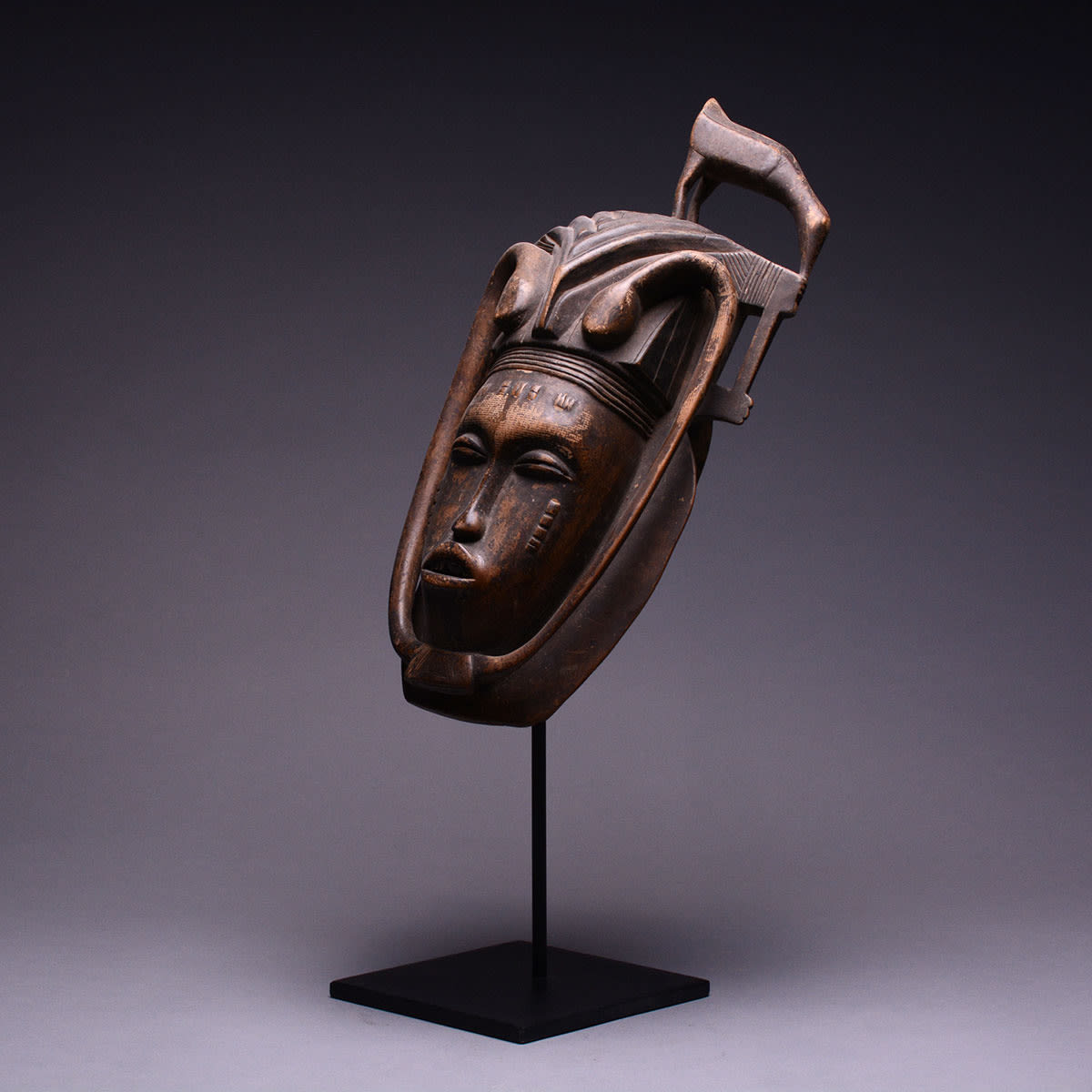Senufo Wooden Face Mask, 20th Century CE
Wood
height 40.6 cm
height 16 in
height 16 in
PF.3378 (LSO)
Further images
This is a kpeliyee mask from the Senufo group of the Ivory Coast area. The face is long, which is standard, but the edge is rimmed with snaked which are...
This is a kpeliyee mask from the Senufo group of the Ivory Coast area. The face is long, which is standard, but the edge is rimmed with snaked which are joined at the chin and curve around on each side of the forehead. The headdress is ample, with a single bird on the left side, bending over with its bill to the ground. The face is refined and well-carved, with arched brows, slit eyes, a long nose and an open mouth with defined teeth. The mask is well patinated, and bears use wear. It is an unusual example of the genre as it does not have the usual appendages and “legs”.
The Senufo live across the Ivory Coast, Mali and Burkina Faso, and are one of West Africa’s most artistically important groups. They are governed by a council of elders and the Poro society, and a religious foundation principle stating that ancestors and bush spirits (mandeo) are all around, and must be appeased. This and other beliefs are visible in their artworks.
Masks include kpeliyee (for dances), buffalo (initiations), horse (celebrating Poro elders) and “firespitter” forms, which are worn for crises and funerals. Healers and highly productive farmers are also entitled to wear masks. The most famous sculptures are the “pombibele” rhythm pounders, which represent primordial humanity, and are used to tamp down the earth of prominent Poro members’ graves. Very large kasingele (first ancestor) sculptures were placed in yasungo shrines, and also appeared in the form of birds (sejen) which are carried by initiates, and which symbolise the authority of the Poro elders (katyleeo) over their juniors (poro piibele). Sandogo divination paraphernalia is also known, while secular items are carved in a very specific manner that echo Senufo deities and spirits, thus providing an apotropaic function.
Kpeliyee (there are various spellings) masks are worn for a number of Poro functions, and may be seen by the public at certain festivals. The manners in which they are carved can betray their precise origin, through carving method and details such as scarifications. The general characteristics are similar, however, with an elongated face, “legs” protruding from the chin, and an array of flanges surrounding the face in the manner of a beard. The most prestigious examples are often surmounted by flourished with symbolic significance for the group, particularly including birds and human figures. Metal versions are also known, and are probably prestige items.
This is a striking piece of African art.
The Senufo live across the Ivory Coast, Mali and Burkina Faso, and are one of West Africa’s most artistically important groups. They are governed by a council of elders and the Poro society, and a religious foundation principle stating that ancestors and bush spirits (mandeo) are all around, and must be appeased. This and other beliefs are visible in their artworks.
Masks include kpeliyee (for dances), buffalo (initiations), horse (celebrating Poro elders) and “firespitter” forms, which are worn for crises and funerals. Healers and highly productive farmers are also entitled to wear masks. The most famous sculptures are the “pombibele” rhythm pounders, which represent primordial humanity, and are used to tamp down the earth of prominent Poro members’ graves. Very large kasingele (first ancestor) sculptures were placed in yasungo shrines, and also appeared in the form of birds (sejen) which are carried by initiates, and which symbolise the authority of the Poro elders (katyleeo) over their juniors (poro piibele). Sandogo divination paraphernalia is also known, while secular items are carved in a very specific manner that echo Senufo deities and spirits, thus providing an apotropaic function.
Kpeliyee (there are various spellings) masks are worn for a number of Poro functions, and may be seen by the public at certain festivals. The manners in which they are carved can betray their precise origin, through carving method and details such as scarifications. The general characteristics are similar, however, with an elongated face, “legs” protruding from the chin, and an array of flanges surrounding the face in the manner of a beard. The most prestigious examples are often surmounted by flourished with symbolic significance for the group, particularly including birds and human figures. Metal versions are also known, and are probably prestige items.
This is a striking piece of African art.





